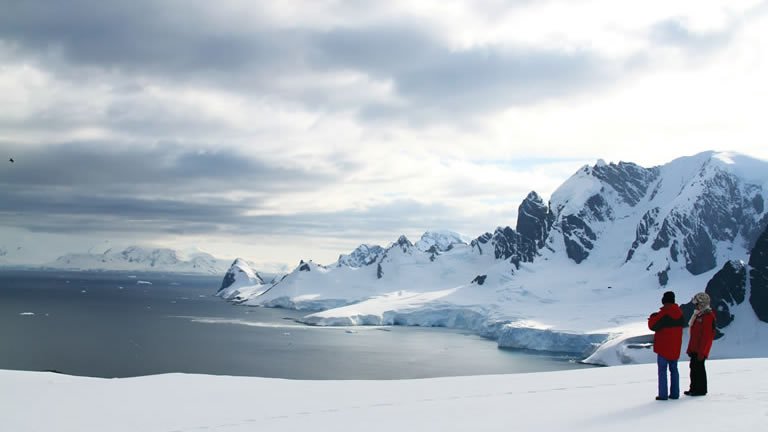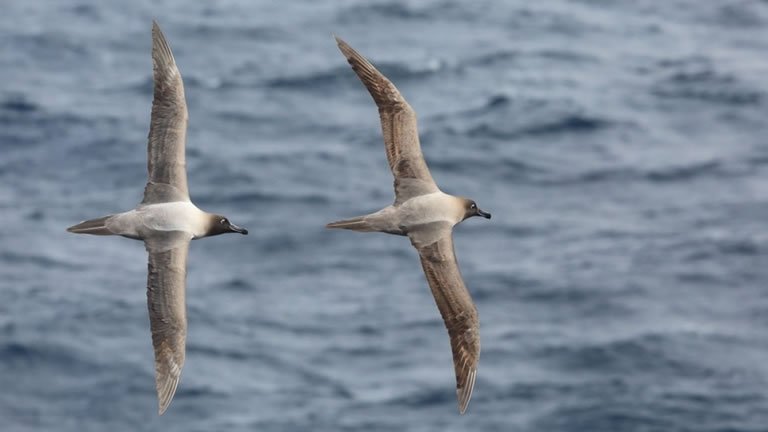Overview
Cruise Itinerary
As the largest of all the South Shetland Island, King George is considered the gateway to Antarctica. At just 120 kilometres from the Antarctic Peninsula and the only airport in the South Shetlands, it is the connection between “real life” and “Antarctic life”. More than 10 different nations have year-round or summer-only scientific research stations on the island (considering that 90% of the island is covered by snow and ice, that is quite an achievement!). Maintaining a base on the island allows membership of the Antarctic Treaty. There is even a Russian Orthodox church, with a permanent on-site priest.
The island might be home to a few international scientists, but they are very much outnumbered by the diverse wildlife that considers King George Island rightfully theirs. Adelie, Chinstrap and Gentoo Penguins all commute to and from the Antarctic peninsula from the island, while Weddell and leopard seals are regular visitors and can be spotted either in the water or on the shore. Naturally, this brings a huge amount of birdlife: skuas and southern giant petrels are regular summer residents, attracted by the warm climate (warm being a relative term, average temperature is between 1.5 and -6.5˚C). The island was named after King George III after British explorer discovered it in 1819. Since then the island has been claimed by both Chile (1940) and Argentina (1943), but remains part of British Antarctic Territory.
The Antarctic Peninsula unravels upwards towards South America, reaching out a beckoning finger to the adventurous, who dare to explore this untamed realm. Stretching up from the heart of the world’s southernmost continent, the Antarctic Peninsula lies a mere 620 mile from Tierra del Fuego and, for many, offers a spectacular first taste of the snow-blanketed landscapes and colossal ice sculptures, which make up Earth’s least-explored continent. Unseen by humans until 1820 - a blink of an eye ago in relative terms - this is an adventure sure to make your hairs stand on end, as you experience the thrill of the truly unknown and extraordinary.
The vast peninsula is sprinkled with research bases, which are at the frontline of human scientific endeavour, pushing to study and understand this unique landscape, its exceptional wildlife, and the impact that humans are having on this pristine continent. Witness cathedral-sized icebergs up close, and blue-hued glaciers, slowly slipping from imposing locations like Hope Bay. Blanched mountain peaks cover the peninsula, and you’ll find thousands of adorable Adelie penguin pairs thriving undisturbed in this peninsula’s unique setting.
Included Shore Excursions:
- Zodiac Cruise with Silversea Expedition team
- Hiking with Silversea Expedition teamA
- Kayaking with Silversea Expedition team
Few voyages ignite the imagination like a journey down to one of the planet’s most remote, extreme and enchanting wilderness, Antarctica. An adventure in its purest form, only a handful of people will ever be lucky enough to experience the majestic beauty of these monochrome landscapes first-hand. The Antarctic Sound will be one of your first encounters of this whitewash kingdom, located at the northerly tip of the Antarctic Peninsula - which sprawls up like a tentacle towards Tierra del Fuego, South America’s most southerly point, otherwise known as the ‘End of the World’.
Taking its name from the first ship to brave the passageway between the peninsular and the Joinville Island groups back in 1902, the Sound is a raw, sensory assault of imposing iceberg slabs, broken away from the disintegrating Larsen Ice Shelf. Come face-to-face with stadium-sized islands of ice and meet the extraordinary birdlife that call this whitewash kingdom home. Watch on, as colonies of Gentoo penguins hop around, and cape petrels sweep overhead, as the continent’s unique wildlife thrives around you.
If you’re planning your first venture into Antarctica, you’ll want to brush up on your photography skills in advance, to capture this unforgiving continent in all of its unrestrained glory. Read our blog for tips on how to ensure that your photos do justice to the adventure of a lifetime.
Included Shore Excursions:
- Zodiac Cruise with Silversea Expedition team
- Hiking with Silversea Expedition team
- Kayaking with Silversea Expedition team
Sailing the legendary Drake Passage is an experience that few are ever lucky enough to experience. The southern tip of the Americas already feels like a wild enough environment – but the sensation of watching the distant cliffs of the peninsular known as the ‘End of the World’ fade into the horizon, is one that’s equal parts epic, eerie and magical.
Set sail, to slowly drop off the bottom of the map from Cape Horn, and voyage on an expedition down into the icy underworld of Antarctica. Drake Passage is an extraordinary voyage of romantic ocean faring legend, as you aim for Antarctica’s icy realm. On arrival, skyscraper sized icebergs salute you, as you traverse the waters of this continent where snow and ice dwelling creatures like penguins and whales roam undisturbed.
Your first sight of this most-unexplored place will most likely be the South Shetland Islands. Walk in the footsteps of some of history’s greatest and bravest explorers as you explore famed, snow-covered landmasses like Elephant and Deception Island. If the journey across Drake Passage sounds daunting, don’t worry – even in rough seas you’re never alone, and will often be accompanied on this spine-tingling adventure by soaring albatrosses and maybe even a protective pod of humpbacks and hourglass dolphins or two. Converging warm and cool ocean currents attract some spectacular animal life to the passage. If this is your first visit to this magical continent, you’ll also want to familiarise yourself with our blog for first timers to Antarctica.
Charcoal-black mountains ladled with snow, giant glaciers and thriving wildlife combine to make South Georgia one of the great natural islands. Adventure to these far flung lands - where the animals are in charge and humans come a distant second. Here you'll witness a cacophony of calling birds, natural set pieces like elephant seals clashing and thrashing, and crowds of colourful king penguins stretching out as far as the eye can see.
An overseas territory of the UK, these isolated, subantarctic islands once formed a remote whaling centre - and you can still visit the former whaling stations. Nowadays the giants of the sea are free to cruise the icy waters uninhibited. Written into explorer history due to its links with Ernest Shackleton’s tale of Antarctic exploration, shipwreck and survival, the Endurance’s crew were saved when he reached the salvation of these shores in 1916 - before returning to collect the remaining sailors from Elephant Island. A museum commemorates the legendary mission, and you can see the memorial to Shackleton that stands over his final resting place on this fabled island.
South Georgia’s colonies of king penguins - with vivid bursts of yellow and orange around their necks - stand, squabble and curiously investigate, enjoying the isolated respite of this island. They’re joined by smaller penguin species like Macaroni penguins, and other glorious birdlife like the majestic wandering albatrosses, which you can see gliding on gusts of wind, over the choppy waves.
Included Shore Excursion:
- Expedition activities with Silversea Expedition team
South Georgia, a remote island in the southern Atlantic Ocean, is a haven for wildlife enthusiasts and history buffs alike. Its rugged terrain is home to vast colonies of king penguins, seals, and other seabirds, set against the backdrop of breathtaking glaciers and mountains. The island played a pivotal role in Antarctic exploration, and the remnants of whaling stations, alongside the grave of explorer Sir Ernest Shackleton in Grytviken, offer a poignant glimpse into its past.
For visitors, South Georgia offers unparalleled opportunities for photography and wildlife observation. Despite its remote location, the island's rich biodiversity and historical sites make it a must-visit for those seeking adventure off the beaten path.
Charcoal-black mountains ladled with snow, giant glaciers and thriving wildlife combine to make South Georgia one of the great natural islands. Adventure to these far flung lands - where the animals are in charge and humans come a distant second. Here you'll witness a cacophony of calling birds, natural set pieces like elephant seals clashing and thrashing, and crowds of colourful king penguins stretching out as far as the eye can see.
An overseas territory of the UK, these isolated, subantarctic islands once formed a remote whaling centre - and you can still visit the former whaling stations. Nowadays the giants of the sea are free to cruise the icy waters uninhibited. Written into explorer history due to its links with Ernest Shackleton’s tale of Antarctic exploration, shipwreck and survival, the Endurance’s crew were saved when he reached the salvation of these shores in 1916 - before returning to collect the remaining sailors from Elephant Island. A museum commemorates the legendary mission, and you can see the memorial to Shackleton that stands over his final resting place on this fabled island.
South Georgia’s colonies of king penguins - with vivid bursts of yellow and orange around their necks - stand, squabble and curiously investigate, enjoying the isolated respite of this island. They’re joined by smaller penguin species like Macaroni penguins, and other glorious birdlife like the majestic wandering albatrosses, which you can see gliding on gusts of wind, over the choppy waves.
Included Shore Excursion:
- Expedition activities with Silversea Expedition team
Days at sea are the perfect opportunity to relax, unwind and catch up with what you’ve been meaning to do. So whether that is going to the gym, visiting the spa, whale watching, catching up on your reading or simply topping up your tan, these blue sea days are the perfect balance to busy days spent exploring shore side.
The Falkland Islands, a remote South Atlantic archipelago, offer a unique blend of rugged landscapes and rich wildlife. Stanley, the capital, is known for its quaint British charm, with colorful houses, cozy pubs, and the historic Christ Church Cathedral. The Falkland Islands Museum provides fascinating insights into the islands’ history and culture.
For nature enthusiasts, the islands are a paradise. Visit Volunteer Point to witness one of the world’s largest king penguin colonies. Gypsy Cove offers excellent opportunities for spotting Magellanic penguins and other bird species. The pristine beaches and dramatic coastlines make the Falklands a perfect destination for hiking and wildlife photography.
Despite it being a stalwart of Britishness, Stanley more resembles Patagonia than Portsmouth. But, despite the windswept, vast and achingly beautiful landscape of the Falkland Islands, don’t be too surprised to find the odd pub serving ales and even fish’n’chips. While landmarks such as Christ Church Cathedral, with its whalebone arch are 100% local, there is a also good smattering of imported garden gnomes and Union Jacks to remind you whose territory you are really on.
The Falkland Islands’ ownership has long been a matter of controversy, ever since colonisation in the 18th century. At various points in their life they have been considered French, British, Spanish and Argentine. The Falklands War in 1982, despite only lasting for a short while, proved that the Brits clung to this remote outpost and the islands remain part of the British Commonwealth today. Margaret Thatcher, under whom the war was masterminded, remains something of a local hero as can be seen in the street signs (such as Thatcher Drive).
For those who want to dig deeper into the past, the Historic Docklands Museum provides lots of information on the chequered historical and political background of the Falklands. However, the true heroes of Stanley are of course the thousands and thousands of penguins. Five species nest here during mating season (including the rare rockhopper penguin). There are virtually no barriers between you and the wildlife; allowing for a truly interactive, authentic and totally unforgettable experience.
Included Shore Excursions:
- Exploring the Highlights of Stanley
- Battlefields – A Mountain Perspective
- Mount William HikeA
- Gypsy Cove Exploration
Meet some of the world’s most incredible wildlife, on the remote Saunders Island. Sitting to the north-west of the Falkland’s archipelago, the British established their first settlement here in 1765, at Port Egmont. Remote, wild and wonderful, the island now serves as a lush grazing ground for plenty of sheep - but it's an astonishing place to encounter far rarer animals - from elephant seals to silvery grebes and Peale’s dolphins. Connected by sinewy links of beach and sandy dunes, which create some of the most dramatic scenery in the Falklands, the archipelago’s fourth biggest island is home to its best birdlife - including a colony of neatly tuxedoed king penguins.
Saunders Island's topography tightens at The Neck - where you'll find even more penguin activity. Colonies squark and chatter in huge crowds here, with Gentoo, Rockhopper and Magellanic penguins dipping into the water, and clambering over boulders. A gentle hike to the summit of Mount Richards will take you 457 metres above sea level, offering an expansive overview, from which you can look out across the tips of the moody waves to see Carcass Island and West Point Island emerging. The cliffs to the north of the mountain host rare black-browed albatross - a sight of sheer grace in flight - but comically clumsy at times when landing. Elsewhere, wide lakes are home to various water birds - including the rare black-necked swans.
A north-westerly outpost of the scenic Falkland Islands, West Point Island is home to a huge colony of black-browed albatross. Originally known as Albatross Island, it was renamed to reflect its geographic location. While albatrosses flash white feathers on rugged cliffs, they share the island with diverse birdlife, including rockhopper and Magellanic penguins, and imperial cormorants, outnumbering the tiny human population and roaming sheep.
Hike the island’s quiet landscapes to see endemic plants like Felton's flower. Marvel at dramatic scenery, with soaring cliffs and towering precipices, including Cliff Mountain, the archipelago's highest cliff. Look out for Commerson's dolphins, whales, and fur seals around the island’s wave-washed shores.
Included Shore Excursions:
- Kayaking with Silversea Expedition team
- Hiking with Silversea Expedition team
Days at sea are the perfect opportunity to relax, unwind and catch up with what you’ve been meaning to do. So whether that is going to the gym, visiting the spa, whale watching, catching up on your reading or simply topping up your tan, these blue sea days are the perfect balance to busy days spent exploring shore side.
Puerto Williams is a Chilean city located on Navarino Island on the southern shores of the Beagle Channel. It claims to be the “southernmost city in the world”, however owing to its small size – 2500 residents approximately – the much larger Argentinean city of Ushuaia, which sits on the northern side of the same channel, also claims that title. The surrounding scenery is magnificent. The wild windswept mountains rise above the tree line and are regularly dusted with snow. The city itself has the dramatic backdrop called “Dientes de Navarino” (literally “teeth of Navarino”), which rival the famous Torres del Paine further to the north. The area was originally used by the Yaghan people, hunter-gatherers who despite enduring the harsh regional climate, could not weather the arrival of Europeans.
The current city was established as a naval base in 1953 and honours the British-Chilean naval commander John Williams Wilson of the 16th century. Initially it served to protect territorial possessions and fishing rights of the area, as well as offering logistical support to Antarctic bases. More recently it has become a departure point for scientific and tourism trips to the Antarctic region. In contrast to the bustle and traffic of a very commercial Ushuaia, Puerto Williams offers a quieter, more relaxed experience. It charms the visitor with a small village feel, complete with rustic buildings and the homely smell of drifting wood smoke. A haven of peace at the end of the world.
Life Onboard Silver Endeavour

Relax in luxury as you discover the furthest corners of the world aboard Silver Endeavour. Read more

Suites aboard the Silver Endeavour are among the most spacious in the luxury cruise industry. Read more

Uncover hidden gems and visit remote locations alongside experts on a zodiac excursion. Read more

Whether your suitcase needs unpacking, or you need a scented bath drawn, white gloved butler service has you covered. Read more

Discuss the day's exploits with a refreshment and live entertainment in this exquisite venue. Read more

Stay active in the onboard fitness centre, or perhaps indulge in one of the Otium Spa's therapeutic treatments. Read more
Brochure

Silversea Antarctica (2024-26)
Availability Click on prices below to view cabin upgrades and details
Tour & cruises prices are per person. Prices shown have savings applied, are subject to availability and may be withdrawn at any time without notice. Pricing and trip details are correct at this point in time, however are subject to confirmation at the time of booking and are subject to change by Silversea. For cruise itineraries, cabin images are sourced from Silversea. These should be treated as indicative only. Cabin inclusions, upholsteries and room layout may differ to the image(s) shown depending on the ship selected and your sailing dates.



















